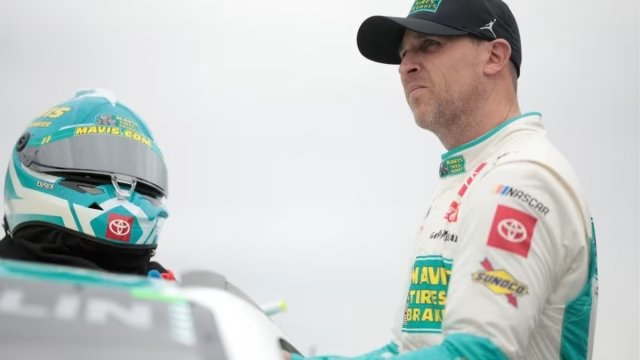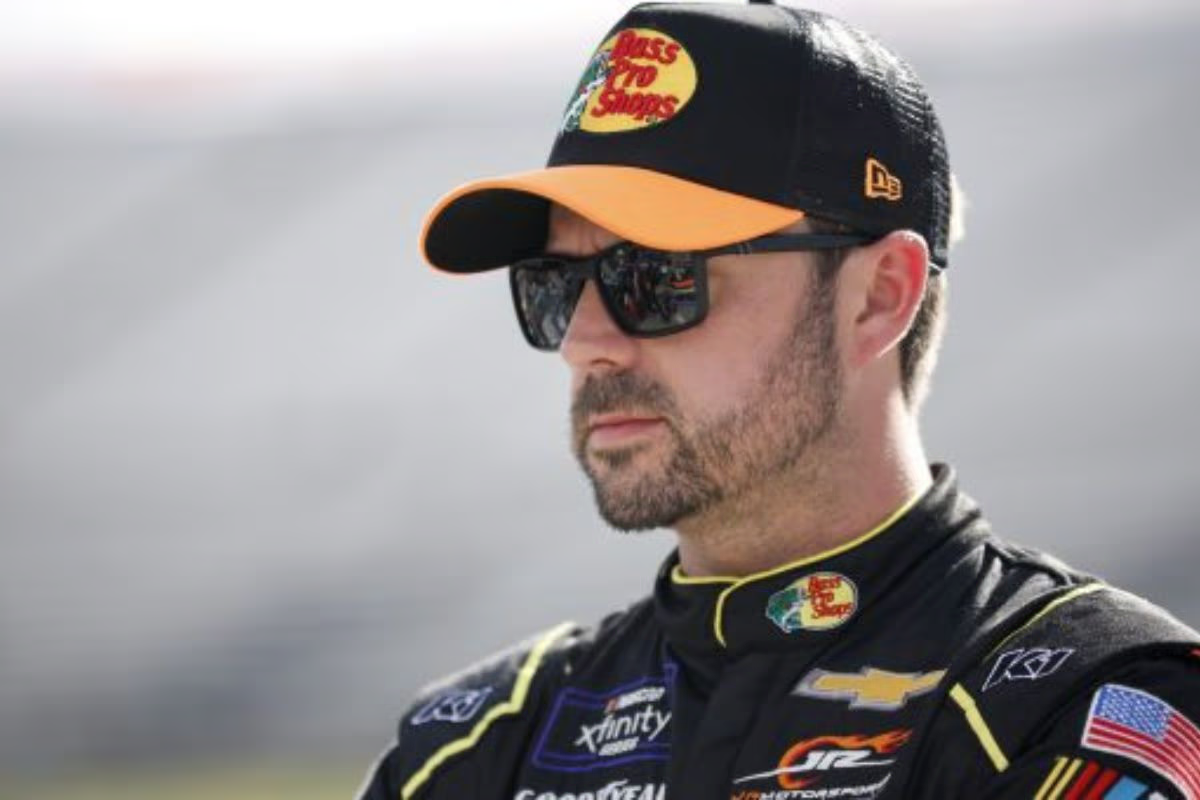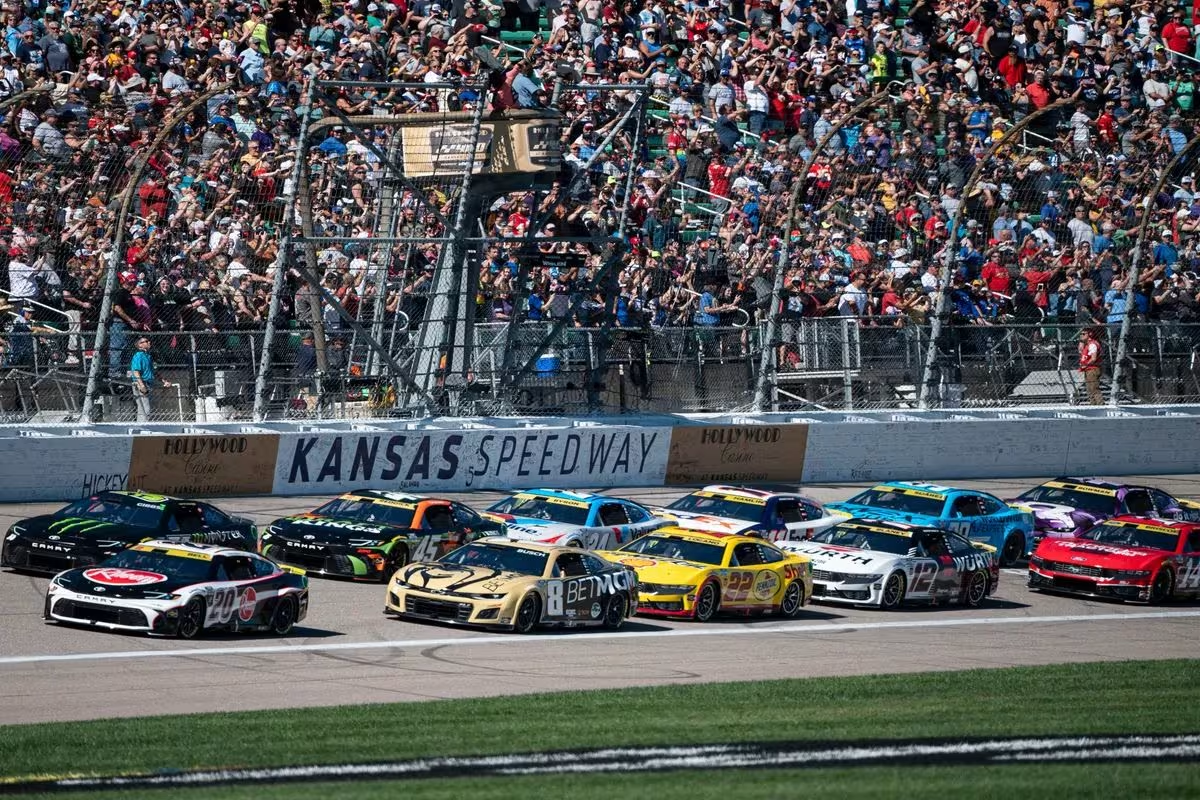Denny Hamlin’s Take on NASCAR’s Kansas Controversy: Denny Hamlin‘s critique of the Kansas controversy brings to the forefront crucial issues surrounding NASCAR’s Damage Vehicle Policy and the broader implications for competitive integrity. By distinguishing between accidents and mechanical failures, Hamlin calls for a more consistent application of rules that could reshape team dynamics and fan perceptions. The incident involving Josh Berry not only ignited discussions on safety but also revealed a pressing need for improved communication between drivers and officials.
Key Highlights
- Denny Hamlin emphasizes the need for clearer communication and understanding of NASCAR’s Damage Vehicle Policy (DVP) among teams and fans.
- He highlights the distinction between accidents and mechanical failures, affecting race outcomes and disqualifications.
- Hamlin calls for collaborative discussions between drivers and officials to enhance rule consistency and fairness in enforcement.
- The Kansas incident with Josh Berry shows ongoing frustrations with DVP enforcement and its impact on competitive integrity.
- Hamlin advocates for NASCAR to reassess policies to improve race excitement and maintain fan engagement.
Josh Berry’s Kansas Incident and Forced Retirement
What led to Josh Berry’s abrupt retirement during the Kansas race? The incident unfolded on the very initial lap, where Berry found himself entangled in a multi-car collision that effectively derailed his chances for a competitive outing. Following the crash, the immediate consequence was catastrophic for Berry’s vehicle; all four tires went flat, rendering the car inoperable.
In NASCAR, drivers facing such a predicament typically have two avenues: they can either retire from the race or attempt to re-enter after repairs. However, an unfortunate twist of fate dictated Berry’s course of action. Due to NASCAR’s regulations at the time, Berry was unable to navigate to the pit lane for necessary repairs, leading to his involuntary retirement.
The situation escalated as a tow truck was dispatched to collect his incapacitated vehicle. Notably, despite being ordered by his crew chief, Rodney Childers, to remain in the car, Berry’s frustration was palpable when he ultimately exited the vehicle, witnessing his competitor’s continued pursuit of victory.
Berry’s abrupt exit not only stripped him of the race but also ignited a wave of discontent that reverberated through the NASCAR community. His emotional outburst resonated with fans and analysts similarly, highlighting the need for a reassessment of race protocols in situations comparable to Berry’s.
Denny Hamlin’s Analysis of Josh Berry’s Car Issue
Denny Hamlin’s analysis of Josh Berry’s car issue sheds light on the complexities inherent in NASCAR’s regulations regarding vehicle damage and race protocol. The incident involving Berry’s No. 4 Ford raises important questions about the interpretation of rules governing tire issues and the consequences for drivers. According to NASCAR guidelines, teams have the option to change flat tires, but when all four tires failed simultaneously, Berry’s car became immobilized, leading to an abrupt end to his race.
Hamlin emphasized several key points during his analysis, highlighting the need for clarity in the rules:
- Accident vs. Mechanical Failure: The distinction between being involved in an accident (which leads to disqualification) and experiencing a mechanical failure (such as a flat tire) is critical in determining race outcomes.
- Towing Protocol: The requirement for a vehicle to be towed back to the pits complicates situations where a car cannot physically return under its own power, creating a grey area in enforcement.
- Communication of Regulations: Hamlin pointed out that a broader understanding of these regulations among teams and fans similarly is fundamental for maintaining trust in the sport.
The Next Gen Car and Rub Blocks Explanation
As discussions around the performance and design of NASCAR’s Next Gen cars continue to unfold, the issue of rub blocks has emerged as a significant topic. Denny Hamlin highlighted the importance of these components, particularly in the context of tire failure. When a tire goes flat, the car’s underbody rests directly on these rub blocks, which serve a protective function. The design aims to prevent damage to the underbody, an area that is often positioned very close to the ground for ideal aerodynamics.
Hamlin referenced Jeff Gluck’s prior discussions, indicating that this design flaw has been acknowledged since the introduction of the Next Gen cars. When the tires deflate, the vehicle’s inability to navigate becomes apparent, as it sits flat on the rub blocks.
“If you are involved in an accident and have damage, you are out. If you spin out on your own and have a flat tire, you will be towed back.” – Gluck
“This was a hot topic when Next Gen was first introduced. I remember because Jeff [Gluck] had been talking yet again, it’s as if we have a flaw in it that when the tires go flat, you can’t move.” – hamlin
This presents a challenge not only for drivers but also for race officials, as it complicates the dynamics of vehicle recovery during events. The necessity for rub blocks highlights the complexity of balancing performance and safety in NASCAR’s evolving technological landscape. As the sport progresses, understanding these elements will be vital for fans and stakeholders similarly.
NASCAR’s Decision and Future Speculation by Hamlin
The recent controversy surrounding NASCAR’s decision-making process has sparked considerable debate among fans and stakeholders, particularly in view of the implications of the Next Gen car design.
Denny Hamlin’s comments regarding the removal of the No. 4 car at Kansas highlight a growing concern about how NASCAR manages competitive integrity and fan engagement.
Hamlin pointed out that the decision to retire a car due to damage, especially when caused by contact with another vehicle, raises questions about the rules governing such situations.
“So, when the tires go flat, you’re sitting flat on the underside—you’re sitting flat on these rub blocks. And what the rub blocks are designed to do is protect the underbody from getting damaged, you know, because we would run these cars just really low to the ground to charge that underbody. So, we have—there’s four rub blocks on the car. And what happens is that when the tires go flat, it sits flat on these.” – Hamlin
Hamlin’s speculations suggest a potential shift in NASCAR’s approach to rule enforcement. He noted, “We’re in the loophole rule books,” indicating that there are opportunities for advancement in the regulatory framework.
Here are three key points for consideration:
- Impact on Competition: Fewer cars on the track can diminish the excitement and competitiveness that fans crave, making a stronger case for rule adjustments to keep the racing dynamic.
- Fan Engagement: A more lenient approach to rules could boost entertainment value, ensuring that fans witness full fields and high-stakes racing, which are integral to NASCAR’s appeal.
- Future Rule Changes: Hamlin’s prediction of a shift in rule application could signify NASCAR’s willingness to adapt, potentially leading to a more robust and engaging racing experience.
NASCAR to Review the DVP Rule and Brad Moran’s Statement
NASCAR’s decision to review the Damaged Vehicle Policy (DVP) emphasizes the growing frustration among drivers and fans regarding the enforcement of rules in situations involving race incidents.
The recent Kansas race incident, where drivers like Josh Berry felt unjustly sidelined, highlights a recurring sentiment within the NASCAR community. This marks the alternate consecutive race where a driver believed they could continue but was ultimately disqualified from competition due to DVP restrictions, following Ryan Blaney’s experience with a similar early-race incident.
NASCAR’s reaffirmation that cars must independently return to pit road to avoid disqualification further complicates the narrative. The policy allows for towing only in cases of spins without contact, leaving many to question its application in diverse racing scenarios.
As reported, the Incident Data Recorder indicated that Berry’s car sustained a considerable impact, justifying its classification under the DVP. Yet, the absence of a lift system—a tool introduced to assist teams post-accident—adds layers of complexity to the incident.
Brad Moran, Managing Director of the NASCAR Cup Series, acknowledged that while the ruling may appear harsh, it adhered strictly to the rule book.
This situation calls for a critical examination of the DVP to guarantee it aligns with the competitive spirit of NASCAR, fostering a balance between safety and the drivers’ ability to compete. As the review looms, the collective voice of the NASCAR community may pave the way for necessary reforms to the DVP.
News in Brief: Denny Hamlin’s Take on NASCAR’s Kansas Controversy
The Kansas controversy serves as a crucial point for NASCAR, highlighting the necessity for an extensive reassessment of the Damage Vehicle Policy and communication protocols. Denny Hamlin’s insights reveal the implications of inconsistent rule enforcement on competitive integrity and team trust. As discussions surrounding safety and fairness continue, collaborative dialogue between drivers and officials emerges as vital for fostering a transparent racing environment. The future of NASCAR may hinge on these reforms, promoting equity and trust within the sport.
ALSO READ: Is Carl Edwards Returning to NASCAR? Denny Hamlin’s Confession Might Surprise You!


